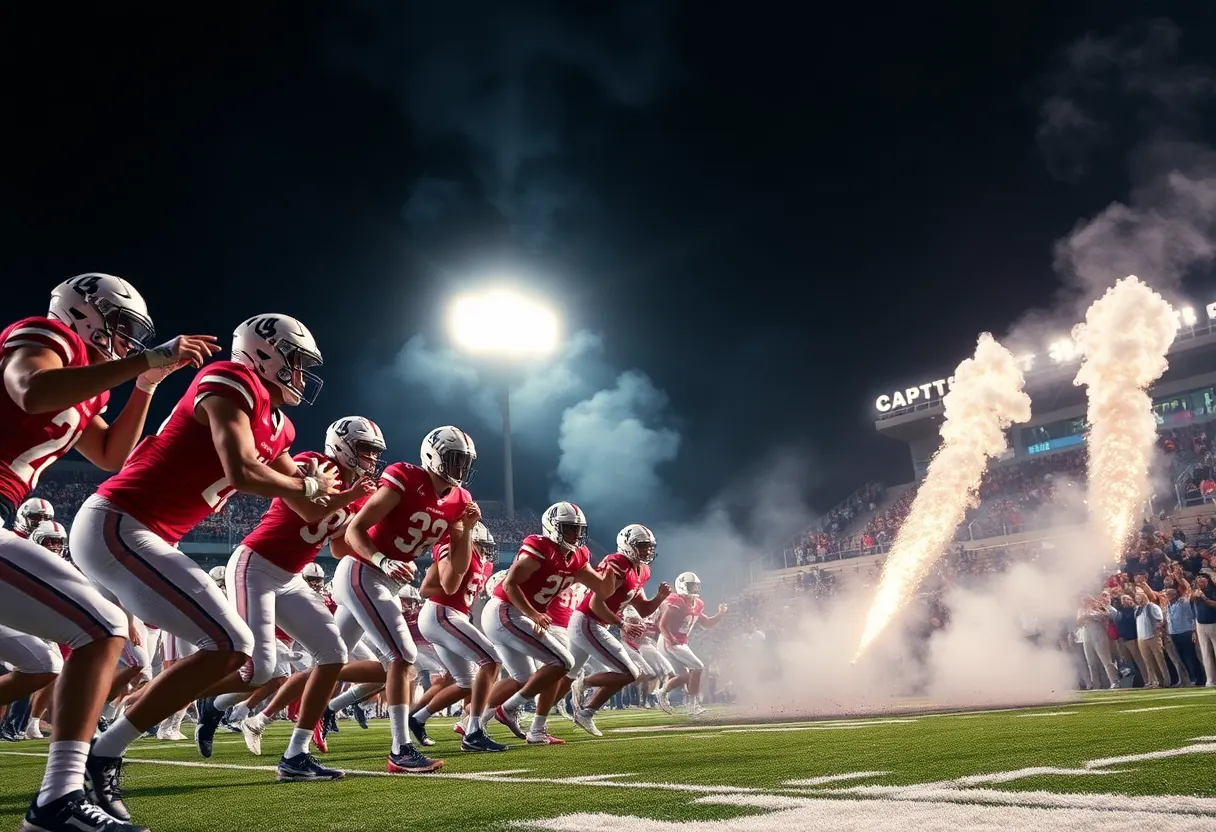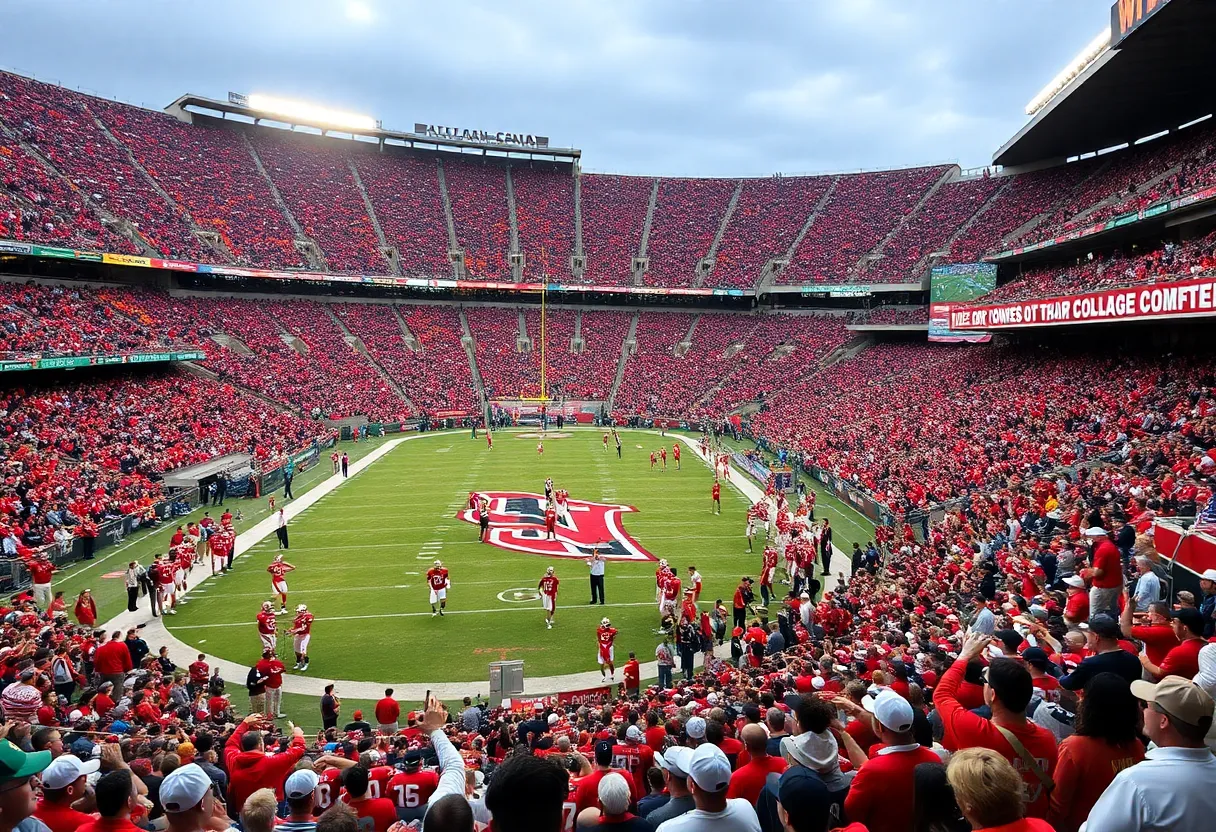Oklahoma City, October 12, 2025
In a thrilling match at the Cotton Bowl, the Texas Longhorns triumphed over the Oklahoma Sooners with a score of 34-27, led by quarterback Arch Manning’s impressive performance. Despite the loss for Oklahoma, this annual rivalry game significantly boosted the local economy, with increased tourism and sales for businesses in Oklahoma City. The event highlighted the close relationship between sports and local commerce, delivering a 20% spike in revenue for nearby establishments and showcasing the ongoing importance of college football for regional prosperity.
Oklahoma City, OK – Texas Longhorns Triumph Over Oklahoma Sooners in Red River Rivalry, Sparking Economic Surge in Local Businesses
In a high-stakes clash known as the Red River Rivalry, the Texas Longhorns secured a 34-27 victory over the Oklahoma Sooners at the Cotton Bowl. Quarterback Arch Manning led the charge with three touchdown passes, propelling Texas to the win. While the outcome marked a defeat for Oklahoma, the event delivered a substantial economic lift to Oklahoma‘s economy through heightened tourism and merchandise sales. This rivalry game, a staple in college football, continues to drive financial benefits for local communities despite the competitive loss.
The matchup drew massive crowds, with local sports bars in Oklahoma City reporting record attendance and generating significant revenue. Fans packed venues to watch the game, boosting sales of food, drinks, and team gear. Businesses near the University of Oklahoma campus experienced a notable 20% increase in sales, highlighting the event’s immediate economic ripple effects. Tourism spiked as supporters from both states traveled to the Dallas-area stadium, filling hotels, restaurants, and shops along the way. Merchandise vendors capitalized on the excitement, moving apparel and souvenirs at a brisk pace, which helped offset any downturn from the Sooners’ loss.
Impact on Local Economy and Community Engagement
The economic uptick extends beyond game day. University officials emphasize the rivalry’s importance in building school spirit and drawing top recruits to the program. This heightened visibility translates into long-term gains for Oklahoma’s athletic initiatives. For instance, the influx of visitors stimulated sectors like hospitality and retail, with many establishments in Oklahoma City seeing sustained business in the days following the event. The game’s national broadcast further amplified interest, encouraging out-of-state fans to plan future trips and spend in the region.
From a business standpoint, the rivalry fosters a sense of community that indirectly supports economic growth. Sports bars not only broke attendance records but also saw repeat customers eager to relive highlights or discuss strategies. This engagement keeps local economies humming, even in the wake of a tough loss. The 20% sales boost near campus underscores how such events create a multiplier effect, where initial spending circulates through suppliers and service providers.
Broader Implications for Oklahoma’s Athletic Future
As both teams shift focus to conference play, Oklahoma’s athletic department is exploring fundraising opportunities to improve facilities. The recent defeat, while disappointing on the field, provides a platform to rally support and investments. Enhanced infrastructure could attract even more talent and fans in upcoming seasons, perpetuating the cycle of economic benefits. The rivalry’s enduring appeal ensures that games like this remain key drivers for regional prosperity.
Looking at the bigger picture, events such as the Red River Rivalry highlight the intersection of sports and business in Oklahoma. The defeat may sting for Sooners fans, but the financial windfall from tourism and sales demonstrates the value of these traditions. Local businesses, from bars to campus-adjacent shops, continue to thrive on the energy generated by such matchups. With Arch Manning’s standout performance for Texas, the game will be remembered for its excitement, but for Oklahoma, it’s the off-field gains that offer a silver lining.
The rivalry’s history adds depth to its impact. Played annually at the Cotton Bowl, it brings together thousands who contribute to the local economy through travel and spending. Oklahoma City, as a hub for Sooners supporters, benefits directly from the pre- and post-game activities. Sports bars that hosted watch parties saw their busiest nights ever, with revenue surges tied to the passionate fanbase. This pattern of economic stimulation has repeated over the years, making the event a cornerstone for community and commerce.
In the aftermath, university leaders are leveraging the game’s visibility to push forward development projects. Fundraising efforts aim to modernize training facilities and stadium amenities, ensuring Oklahoma remains competitive. The 20% sales increase serves as evidence of the event’s power to energize local markets. As preparations for the next season begin, the focus remains on turning competitive setbacks into opportunities for growth and investment.
Overall, the Red River Rivalry exemplifies how sports events can bolster Oklahoma‘s economy. The Texas victory may have ended the game on a low note for the Sooners, but the surge in tourism, merchandise sales, and local business revenue paints a positive economic story. Communities like Oklahoma City stand to gain as long as these traditions endure.
FAQ
What was the outcome of the Red River Rivalry game?
In a thrilling Red River Rivalry, the Texas Longhorns defeated the Oklahoma Sooners 34-27 at the Cotton Bowl.
Who led the Texas team to victory?
Quarterback Arch Manning threw three touchdowns, leading Texas to the win.
How did the game impact Oklahoma’s economy?
The win boosts Oklahoma’s economy through tourism and merchandise sales, despite the team’s loss.
What did local sports bars in Oklahoma City experience?
Local sports bars in Oklahoma City reported record crowds, generating significant revenue.
What is the rivalry’s role according to university officials?
University officials note the rivalry’s role in fostering school spirit and attracting recruits.
How did businesses near the University of Oklahoma campus fare?
Businesses near campus saw a 20% uptick in sales, underscoring the event’s economic ripple effects.
What are Oklahoma’s athletic department plans post-game?
As both teams prepare for conference play, Oklahoma’s athletic department eyes fundraising opportunities to enhance facilities amid this high-profile defeat.
Economic Impact Chart
Below is a simple bar chart representation of key economic features from the Red River Rivalry event, illustrating the boosts in various sectors.
| Sector | Impact Description | Percentage Increase (Where Applicable) |
|---|---|---|
| Tourism | Boost through visitor influx | Not specified |
| Merchandise Sales | Increase in team gear and souvenirs | Not specified |
| Sports Bars in Oklahoma City | Record crowds and significant revenue | Not specified |
| Businesses Near Campus | Uptick in sales | 20% |
| Fundraising Opportunities | Eyes on enhancing facilities | Not specified |
Deeper Dive: News & Info About This Topic
HERE Resources
Oklahoma State Cowboys Defeat Houston Cougars 28-17 in Big 12 Clash
Sooners Edge Longhorns 24-20 in Thrilling Red River Rivalry
OU Superfan Celebrates 70 Years at Red River Rivalry
Tulsa Expands Local News Coverage with New Resources
Oklahoma City Week 7 High School Football Scores Impact Rankings
Pauls Valley Sooner Marching Band Performance Energizes Local Community
Fatal Fire Claims One Life in Southwest Oklahoma City
Violent Incident at Oklahoma City School Bus Stop Sparks Parental Outrage
Lifelong Fan to Attend 70th Consecutive OU-Texas Rivalry Game
OU-Texas Red River Rivalry Heats Up with Sooners’ Quarterback Boost




